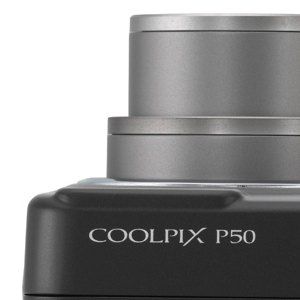The Nikon Coolpix P50 sits on the bottom rung of three “Performance” Coolpix models Nikon has in that range which also includes the P5000 and P51000. As such it offers a more affordable balance between specification, shooting tools and user control in a package that is wrapped in what Nikon calls and “classic” camera package but that in reality means it looks more like a “proper” camera than snapping gadget. Traditionalists will like it.
Our quick take
Some sluggish performance aspects mar excellent image quality and low noise; nevertheless, the Nikon Coolpix P50 is almost perfectly pitched for the target market. Not bad, not bad at all.

Nikon Coolpix P50 digital camera - 4.0 / 5
| FOR | AGAINST |
|---|---|
|
|
And its styling and design lend themselves to nice handling and the large right-hand grip that houses the dual AA batteries and SD/MMC external storage (you also get 52MB of internal storage space as well) makes it feel very comfortable to use indeed.
Backing that up is a nice sized mode dial on the top plate just behind the shutter button and to the left of the on/off button. Start up is a modest 2.5-seconds so not particularly fast but reasonable for a camera at this price. The continually rotating mode dial allows you too quickly click through the camera’s shooting modes that includes a full manual option, all auto green mode and a program AE setting.
Three key scene modes can be quickly selected here too (landscape, night scene and portrait modes with another 12 scene modes in menus as well as a voice annotation mode and unusually, two image size settings are available via the scene mode menu as well.
A “HI ISO” mode quickly selects the top and what Nikon calls “Electronic Vibration Reduction” with a top ISO 2000 mode and provides the route into the camera’s 640 x 480 movie mode. You also get a very natty time-lapse movie mode for snapping an image at predefined time intervals from one every 30-seconds to an image every 60-minutes.
Other key kit includes an excellent 28mm to 102mm F/2.8 to F/5.6 3.6x Nikkor zoom lens and Nikon’s new EXPEED image processing engine that helps sort problems with noise issues while preserving image quality. More on that shortly. The camera has a rather horrible, dark and blurry optical viewfinder to back up the (by today’s standards) small 2.4-inch colour screen.
The screen is however bright and easy to use in all but the brightest of direct sunlight when things become more of a challenge, not helped by the screen’s rather reflective coating. The Face Priority AF system is reliable but I found it to be slow to use even though it can recognise up to 12 faces in a shot to help keep them both sharp and properly exposed.
The non-Face AF system is less sluggish but what frustrates me more is the shutter lag, which when combined with slow AF means you end holding the shutter button down to try to get a shot, nothing happens you’ve lost the opportunity to snap or the moment has passed, drop the camera and it then promptly takes a picture of your shoes.
Once I got used to these foibles things improved but it’s not the best of performances for anyone wanting to capture anything more fleeting in terms of snaps. The manual controls on offer provide scope to play with both shutter and aperture settings and these are backed up by +/-2EV exposure compensation in all shooting modes.
In terms of image quality, the P50 is pretty darn good with a stunning level of detail captured at top quality and low ISO settings. And although the 256-zone Matrix metering system to underexposes by around half a stop when shooting in scene modes, which seemed rather at odds with the superb metering performance in the program mode; I found the exposure compensation rather more useful than I would have wanted.
The EXPEED processor works well and even over ISO 800 noise is evident but well controlled well – looking very much like traditional film grain. Over ISO 800, noise is more problematic but not as bad as most cameras at settings over ISO 1000 though colour does become rather more muted as the ISO creeps up.
White balance is excellent and the level of detail is also very good indeed even with noise processing switched on, which can sometimes smooth detail out of an image as it fights the affects of noise. Colours are natural looking with plenty of presets and tweaking available in menus including black and white and a variety of other tweaks such as Vivid, Softer, More Vivid and the like helping you to fine tune your results.
The Nikon Coolpix P50 is a simple to use snapper with some nice advanced and manual modes and great image quality. It may be sluggish but on balance is one of the better options in this sector of the market available today.
To recap
The Nikon P50 is a neatly-crafted digital compact with “classic” styling aimed at snappers on a tighter budget
